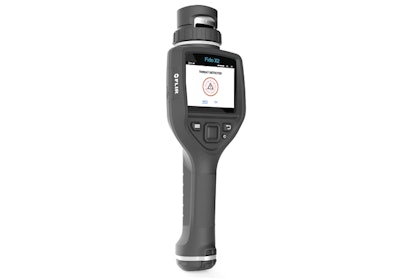 FLIR Detection's Fido X2 quickly identifies trace explosives and has a large screen to display results and show training videos. (Photo: FLIR Detection)
FLIR Detection's Fido X2 quickly identifies trace explosives and has a large screen to display results and show training videos. (Photo: FLIR Detection)
Dogs are known for having extremely sensitive noses, which is why they're so valuable for detection duties. But using K-9s to sniff out bombs necessitates time and money to train, feed, and otherwise maintain the animals—none of which is an issue for a machine. Such was the reasoning that brought about FLIR Detection's Fido X2 explosives trace detector. It was born out of a Department of Defense DARPA program called Dognose to develop an electro-mechanical system that could mimic the performance of a dog's nose, hence the tongue-in-cheek name Fido.
While FLIR Detection had great success using the Fido line to detect explosives in theater with the military, the company wanted to develop a device uniquely suited to first responders. After testing the military version, officers requested changes in ergonomics and price to better fit their daily needs. The result is the Fido X2.
"The Fido X2 system was specifically developed to incorporate the core performance from the DARPA Dognose program and military applications into something for first responders. That philosophy drove the X2 line," says Dennis Barket Jr., vice president and general manager for FLIR Detection.
To make it easier for officers to carry, the rugged and very portable Fido X2 was designed to weigh less than 1.5 pounds with what Barket calls "smaller ergonomic and aesthetic handheld positioning."
Law enforcement can use the Fido X2 for first-level screening at security checkpoints or during high alert stages to detect explosive residue on vehicles and personal belongings and get results within 10 seconds. "You take a wipe and you can swipe a backpack, someone's hand, or car handles, put the small swipe into the Fido X2, and it heats up and essentially sniffs the vapors and provides a response of whether these particles have trace explosives or not," Barket explains. Its algorithms detect trace amounts of a broad range of materials, including homemade explosive components that were added for law enforcement use.
TrueTrace technology makes this possible. "It's very sensitive, using fluorescent polymers and other chemi-luminescent types of detection techniques," says Barket. "There is air that is actually pulled through these detection cells, and explosives materials will provide a response, and that response will get translated to an alarm or an all-clear to give the first responder a signal to know if there are explosives on the swipe. It's real time and provides confidence on site."
A new larger screen on the Fido X2 displays the results of a swipe and uses prompts to guide officers through any next steps needed. The screen also shows short pre-loaded training videos on topics such as sample collection and how to get the most out of the product to increase ease of use. "We've received a lot of great feedback on [our videos available] at the touch of a button, through the screen, right there for any user to refresh or train for the first time," says Barket.
FLIR Detection is taking orders for the Fido X2 now and will start shipping the product in March. The cost will be just under $10,000.
Barket says, "We're excited about being able to tailor the Fido X2 specifically to first responders, giving them this kind of explosives detection capability in a small, handheld system."


